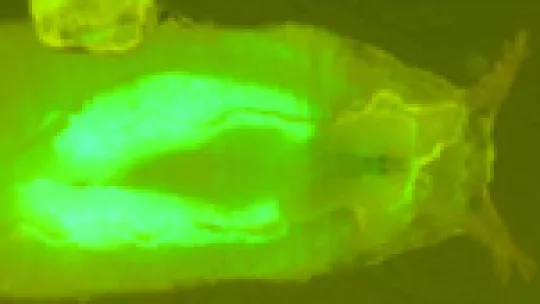Images
The protein DOR controls the maturation of adult flies depending on availability of nutrients
The protein DOR activates a number of genes that larvae of the fruitfly Drosophila melanogaster need in order to transform into adult flies, scientists at IRB Barcelona have discovered. During this process, called metamorphosis, the flies’ cells receive a number of signals which instruct them to grow and mature into their final shape and size. Working with fruitfly larvae, IRB Barcelona researcher Victor Francis has shown for the first time that the protein DOR plays a role in the pathway of the hormone ecdysone to make the transformation complete. The study was led by Antonio Zorzano, coordinator of the IRB Barcelona’s Molecular Medicine Programme and Professor at the University of Barcelona, and by Aurelio Teleman, from the German Cancer Research Center in Heidelberg, Germany, and was published in the journal Current Biology.
One of the molecules that governs metamorphosis of fruitfly larvae is a steroid hormone called 20-hydroxyecdysone (20E). During larvae development 20E binds to a protein receptor found in the nucleus of cells and controls the genes that determine the shape and size of the fly. By studying flies lacking the protein – the first time that this protein has been studied in vivo – they determined that DOR binds to its receptor to control the protein’s function and activate the genes responsible for the insect’s development.
One of the factors that controls metamorphosis is the presence of nutrients that a fly uses to obtain energy. The scientists demonstrated that insulin, which promotes energy consumption, uses DOR to inactivate ecdysone, which has the opposite effect and promotes enery procurement. A clear example of the relationship between mechanisms of insulin and ecdysone in mammal cells is that diabetic rats have altered DOR. The opposing functions of these two pathways suggest that they must achieve a balance in order for the larvae to develop correctly, and open new possibilities for the study of human diabetes.
Reference
article:
dDOR
is an EcR coactivator that forms a feed-forward loop connecting
insulin and ecdysone signaling
Vıctor
A. Francis, Antonio Zorzano and Aurelio A. Teleman.
Current
Biology (2010) [DOI: 10.1016/j.cub.2010.08.055]
About IRB Barcelona
The Institute for Research in Biomedicine (IRB Barcelona) pursues a society free of disease. To this end, it conducts multidisciplinary research of excellence to cure cancer and other diseases linked to ageing. It establishes technology transfer agreements with the pharmaceutical industry and major hospitals to bring research results closer to society, and organises a range of science outreach activities to engage the public in an open dialogue. IRB Barcelona is an international centre that hosts 400 researchers and more than 30 nationalities. Recognised as a Severo Ochoa Centre of Excellence since 2011, IRB Barcelona is a CERCA centre and member of the Barcelona Institute of Science and Technology (BIST).





